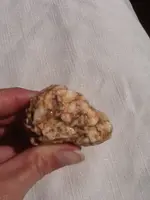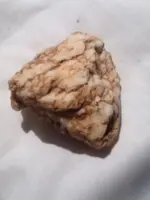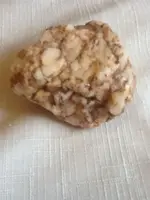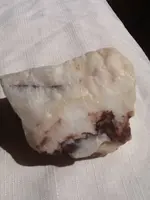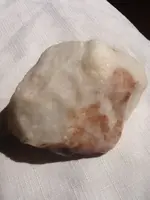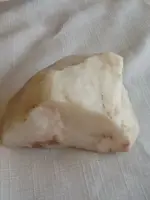Dustedyou
Hero Member
- Joined
- Dec 27, 2012
- Messages
- 611
- Reaction score
- 399
- Golden Thread
- 0
- Location
- Albuquerque
- Detector(s) used
- Gold Bug, Treasure finder. Gold Cube, Chisel, Hammer, Eye Loop.
- Primary Interest:
- Prospecting
- #1
Thread Owner
So we went out to hit a spot for "Sandstone gold" Placer gold from the pleistiocene Gorgeous 95 degree weather.. lol drank 5 gallons of water ..kiddos melted ..
no one wanted out of the shade except the wife! YAY! lol but as we topped the mountain we found a huge pile of ore chucked out during the silver run of 1887,
and low and behold there is Cerillos Turquoise staring me in the face.. 80 lbs and a mile later we got it to the truck.. and i got in some picts today! Let me know what you think!
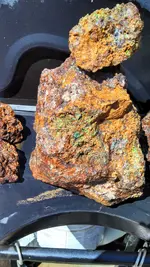
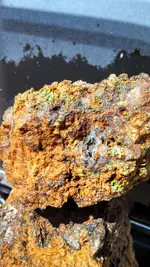
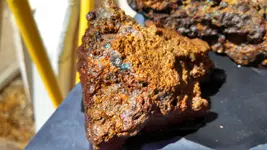
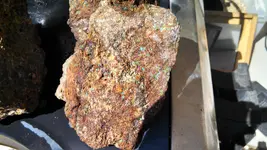
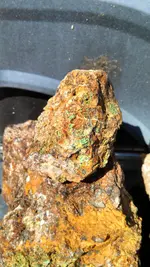
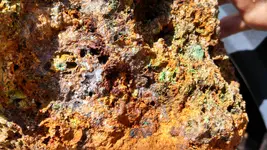
For anyone not knowing the importance of Cerillos Turquoise here is a little background:
780 AD native americans mined the turquoise for the Chief and medicine man (they conssider the blue to be teardrops from the sky gods fallen to earth.), this practice continued till ocupation of the Santo Domingo Pueblo in 1680 when one of the mines in cerillos collapsed killing 33 indians and they revolted killing off several hundred Spanish conquistadores and friars.
The mines were used clear thru till the silver rush of 1887, where the prospectors would throw out the turquoise or grind it for the silver and gold.
Tiffany & Co.'s history with New Mexico
What does ultra-chic Tiffany's have in common with New Mexico? More than you'd expect.
The Tiffany mine named after Tiffany's of New York delt with American Turquoise CO till 1914 when it bought them out.
A New Mexico turquoise mine. The American Turquoise Company sold almost all of its turquoise directly to Tiffany & Co.
From late-1800s Tiffany-Blue turquoise to a spectacular early 20th century silver service, Tiffany's ties to New Mexico are among the surprises awaiting visitors to the New Mexico History Museum, which opened May 24.
For the Tiffany tales' beginnings, go back to 1837, when Charles Lewis Tiffany founded Tiffany and Young, a fine-goods emporium that introduced a novel idea of the time: the non-negotiable selling price.
In that same year, Tiffany introduced the famous "Tiffany Blue Box" — a cherished trademark of Tiffany & Co.
In 1889, George F. Kunz, the company's renowned gemologist, won an award in Paris for a collection that contained a sample of New Mexico turquoise. In 1892, Kunz announced that certain colors of turquoise had come to be considered "gem quality" — namely, the Tiffany Blue color.
According to a New York newspaper: "That is a turquoise far and away the finest in America, and it came from these new mines in New Mexico. It is worth $4,000. ... t is probable that gems to the value of $200,000 a year may be obtained from this mine."
Clearly, Kunz had recognized the possibilities of further branding the Tiffany Blue color by maintaining almost-exclusive rights to the turquoise he made suddenly valuable.
In that same year, James P McNulty came to Cerrillos, New Mexico, to mine turquoise, eventually landing with the American Turquoise Company, which owned the claims to a number of mines. The turquoise mined in Cerrillos at the time was of a very specific color — Tiffany Blue — and the ATC sold almost all of its turquoise directly to Tiffany & Co.
no one wanted out of the shade except the wife! YAY! lol but as we topped the mountain we found a huge pile of ore chucked out during the silver run of 1887,
and low and behold there is Cerillos Turquoise staring me in the face.. 80 lbs and a mile later we got it to the truck.. and i got in some picts today! Let me know what you think!






For anyone not knowing the importance of Cerillos Turquoise here is a little background:
780 AD native americans mined the turquoise for the Chief and medicine man (they conssider the blue to be teardrops from the sky gods fallen to earth.), this practice continued till ocupation of the Santo Domingo Pueblo in 1680 when one of the mines in cerillos collapsed killing 33 indians and they revolted killing off several hundred Spanish conquistadores and friars.
The mines were used clear thru till the silver rush of 1887, where the prospectors would throw out the turquoise or grind it for the silver and gold.
Tiffany & Co.'s history with New Mexico
What does ultra-chic Tiffany's have in common with New Mexico? More than you'd expect.
The Tiffany mine named after Tiffany's of New York delt with American Turquoise CO till 1914 when it bought them out.
A New Mexico turquoise mine. The American Turquoise Company sold almost all of its turquoise directly to Tiffany & Co.
From late-1800s Tiffany-Blue turquoise to a spectacular early 20th century silver service, Tiffany's ties to New Mexico are among the surprises awaiting visitors to the New Mexico History Museum, which opened May 24.
For the Tiffany tales' beginnings, go back to 1837, when Charles Lewis Tiffany founded Tiffany and Young, a fine-goods emporium that introduced a novel idea of the time: the non-negotiable selling price.
In that same year, Tiffany introduced the famous "Tiffany Blue Box" — a cherished trademark of Tiffany & Co.
In 1889, George F. Kunz, the company's renowned gemologist, won an award in Paris for a collection that contained a sample of New Mexico turquoise. In 1892, Kunz announced that certain colors of turquoise had come to be considered "gem quality" — namely, the Tiffany Blue color.
According to a New York newspaper: "That is a turquoise far and away the finest in America, and it came from these new mines in New Mexico. It is worth $4,000. ... t is probable that gems to the value of $200,000 a year may be obtained from this mine."
Clearly, Kunz had recognized the possibilities of further branding the Tiffany Blue color by maintaining almost-exclusive rights to the turquoise he made suddenly valuable.
In that same year, James P McNulty came to Cerrillos, New Mexico, to mine turquoise, eventually landing with the American Turquoise Company, which owned the claims to a number of mines. The turquoise mined in Cerrillos at the time was of a very specific color — Tiffany Blue — and the ATC sold almost all of its turquoise directly to Tiffany & Co.



